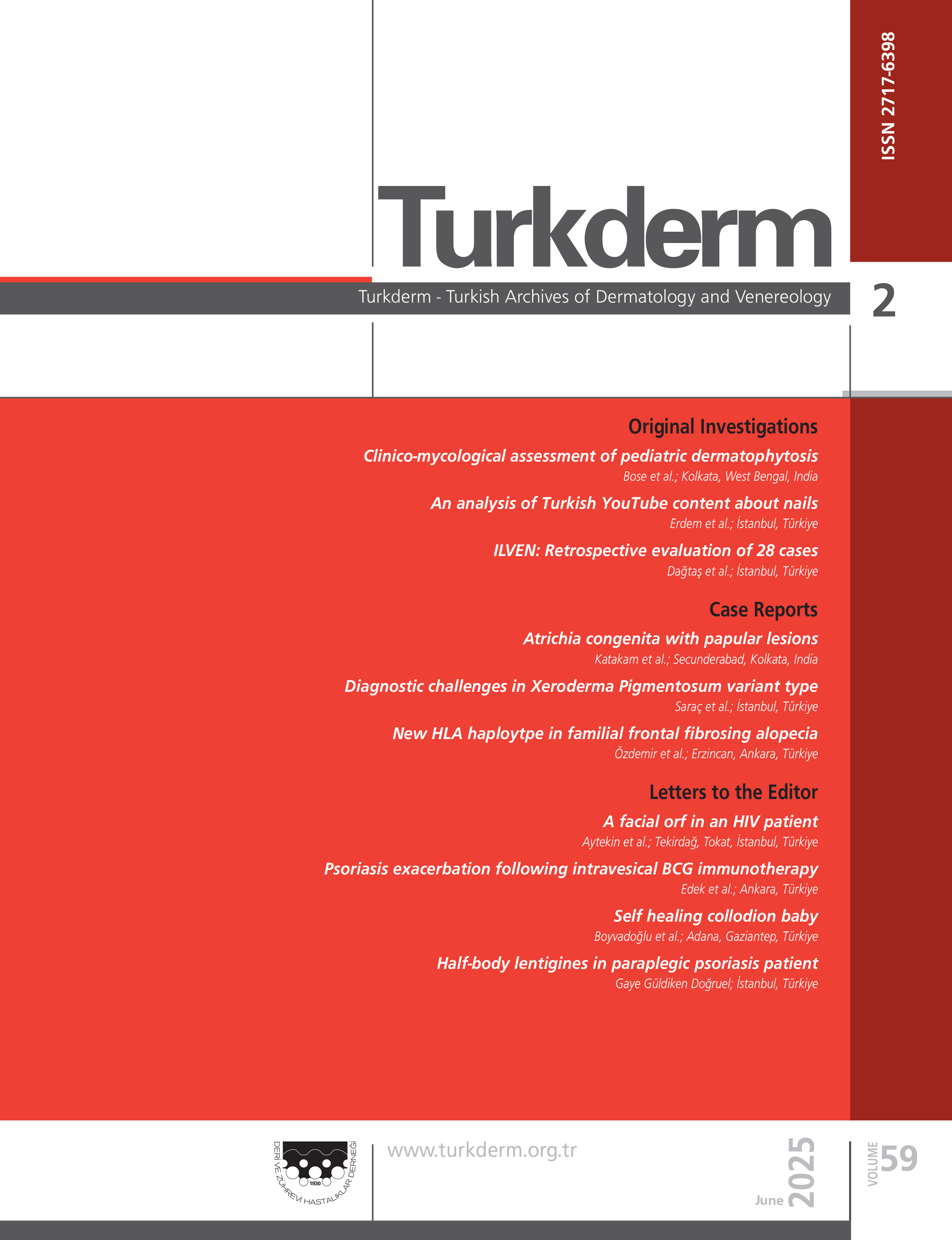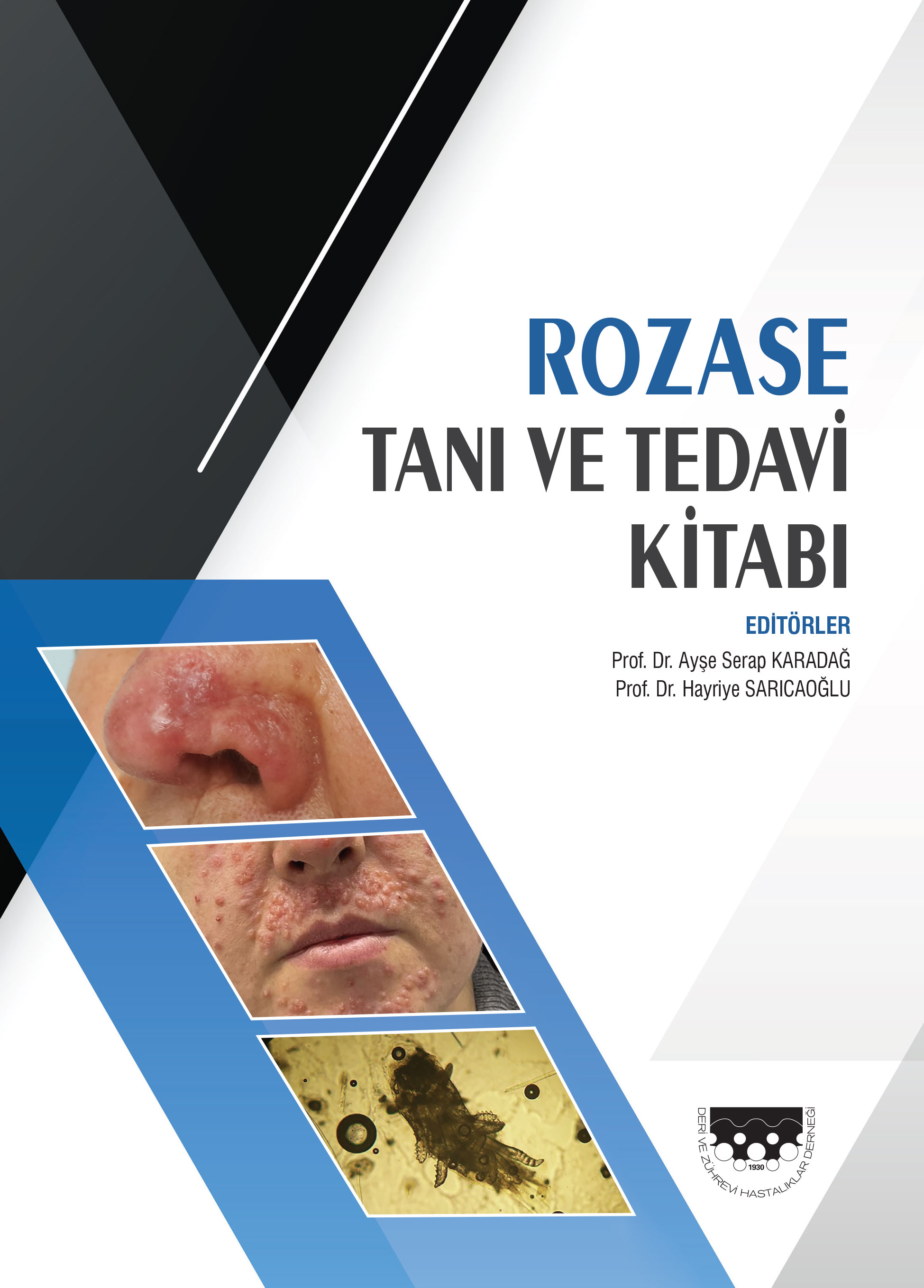Volume: 39 Issue: 1 - 2005
| BAŞYAZI | |
| 1. | Amerika Birleşik Devletlerinde Dermatoloji Asistan Eğitimi: Türk Dermatoloji Asistan Eğitiminde Yeni Bir Model Oluşturulabilir mi? Gonca Gökdemir, Adem KöşlüPages 14 - 19 Abstract | |
| 2. | Aproaches in the treatment of alopecia areata Ekrem Aktaş, Deniz Aykol Pages 20 - 27 While the treatment of alopecia areata (AA) is being planed, many factors, such as especially the size of the lesion, age of the patient and the gender, the duration of the disease, the characteristics of the lesion and the possibility of pregnancy, should be taken into consideration. By investigating both Turkish and foreign literatur on the treatment of AA, we classified general aproaches and new treatment methods in this field at follows; A-Conservative and new treatment methods; Corticosteroids, minoxidil, anthralin, immunmodulators, fotochemoterapy, others; cyclosporine, sulfosalazin, interferon, tacrolimus, nickel ve izoprinozine, dapson, imiquimod, thalidomid, aromatherapy, cryotherapy, acupunkture, timektomy, selektive seratonin reuptake inhibitors (SSRI), nonpharmacologic methods, psychiatric treatment aproaches and patient education. B-Recent investigating on hair regrowth; Hair follicules culture systems and scalp implantations C-Genetic treatments |
| 3. | The frequency of menstruel irregulation, acne, seborrhea and androgenetic alopecia in women with hirsutizm Filiz Cebeci, Nahide Onsun, Ömer Ümmetoğlu Pages 28 - 31 Background and design: Increased androgen sensitivity in pilosebacous unit causes hirsutism, acne, seborrhea and androgenetic alopecia. The term hirsutism refers to distribution of hair in masquline pattern in women. In this study we investigated whether cutaneous androgenization findings like menstrual irregularity, acne, seborrhea, androgenetic alopecia always appear together clinically. Materials-Methods: 347 patients with hirsutism between 17-40 years of age who were diagnosed as hirsutism in our Dermatology Clinic between 1999-2004 were enrolled in our study. We used Ferriman-Gallwey scale for diagnosis. Accompanying findings like amenorrhea, oligomenorrhea and polimenorrhea were noted. Seborrhea was evaluated subjectively while acne was diagnosed clinically. Androgenetic hair loss was evaluted according to Ludwig model. Results: In our study group seborrhea, acne, menstruel irregulation and androgenetic alopecia accompanied to hirsutism 57.34%, 53.89%, 42.07% and 8% respectively. The ratio of appearence as SAHA syndrome (seborrhea, acne, hirsutism, androgenetic alopecia) was only 2.5 %. We decided that all components of syndrome dont always appear together. Conclusion: In studies which evaluate clinical findings of peripheral androgenism, it is interesting to encounter Ludwig model alopecia infrequently compared to other symptoms. Our study supports the idea that real factor in the development of androgenetic alopecia is the degree of genetic predisposition rather than androgens. |
| 4. | Serum ACE activity in patients with psoriasis vulgaris Mukaddes Kavala, Zafer Türkoğlu, Müyesser Ertuğrul Pages 32 - 35 Background and design: Neuropeptides are accused in the pathogenesis of psoriasis.The aim of this study was to evaluate the serum level of angiotensin-converting enzyme (ACE) in psoriasis vulgaris patients and its relation with the disease and therapy. Materials and methods: Serum ACE levels were measured spectrophotometrically in patients with the diagnosis of psoriasis as 132 patients before and 121 patients after therapy and then in control group of 65 individuals. 112 patients had topical and 20 patients had systemic (acitretine) therapy. 11 patiens who applied topical therapy were lost to follow-up and excluded from the study. Results: Serum ACE levels of the patients (38.76 U/L) was statistically significantly increased compared to control group(27.6 U/L) (p<0.001).Serum level of ACE before treatment (38,13 U/L) was statistically significantly reduced after treatment (32.22 U/L) when compared each other in psoriasis patients(p<0.001). and the decrease of ACE level after topical therapy (% 15.68 ) was higher than systemic therapy(%5,4 ). Conclusion: Our findings suggest that there is a relation between serum ACE activity and psoriasis vulgaris. In the following years serum ACE might be a spesific parameter for neurogenic inflammation in psoriasis with new studies on tissue and serum. |
| 5. | Lens changes in alopecia areata Pages 36 - 39 Background and design: Alopecia areata (AA) has been accepted as a systemic disease because of its association with some autoimmune diseases and involvement of nail and eye. Ocular alterations have previously been reported in alopecia areata. Indeed, there have been reports of various lens alterations, from cases of cataract to minor punctate opacities. However, there are contrasting opinions as to the prevalence of these lens changes. Involvement of the chorioretina has also been reported in AA, but the significance and etiopathogenesis of both the lens changes and the fundus alterations in patients with AA is obscure. The purpose of this case-control study was to investigate the prevalence and appearance of the lenticular changes occurring in AA. Materials and Methods: One hundred patients (45 women, 55 men; age range 2-70) with AA who were seen at the Dermatology Clinic of Istanbul Medical Faculty were referred for ophthalmological examination including slit-lamp examination as part of the study. One hundred healthy control patients (50 women, 50 men) were also included in this study. Results and Conclusion: There was no statistical difference between the patient and control groups regarding the rates of lenticular alterations. Asymptomatic lens opacity was found in 27 of the 100 patients and 25 of the controls. Cataract was not found either in patient or in control groups. Our data support the hypothesis that lens opacities in patients with AA do not have any significant clinical relevance. So, the opinion of advising ophthalmological examinations in AA patients, emphasized by some authors is not supported. |
| 6. | Uygulamalı Lazer Kursu Page 40 Abstract | |
| 7. | Is there an any role of neuropeptide Y in the etiology of vitiligo? Savaş Yaylı, Sevgi Bahadır, Orhan Değer, Gülseren Cimşit, Köksal Alpay Pages 41 - 45 Background and design: It is suggested that various neuropeptides secreted by nerve fibres may cause to vitiligo.In this study, we measured the serum NPY levels of the patients in order to investigate the possible role of NPY in the clinical types and its relevant influence on the activity of the disease in the patients with vitiligo. Materials and methods: Thirty-five patients with vitiligo and 30 healthy volunteers as controls were enrolled in the study. The patients were grouped according to clinical types and the disease activity of vitiligo. The serum NPY levels of the patients and the controls were measured and compared to each other. Also, the serum NPY levels of the groups arranged according to clinical types and the disease activity were compared to each other. Results: There was no difference between the patients with vitiligo and controls in the average serum levels of NPY (p>0.05). The average levels of NPY in the patients with generalized, focal and segmental types of vitiligo were compared to controls. The results did not reflect any statistical importance (p>0.05). When the average NPY levels of the clinical types of the disease were compared to each other, there was no difference (p>0.05).There was no difference in the NPY levels between the patients with progressive disease and those in stable disease, too (p>0.05). |
| 8. | Congenital multiple glomangiomas: case reprt Emine Derviş, Gül Barut, Sadullah Karun Pages 46 - 50 Glomangiomas are benign tumors arising from neuromyoarterial cells surrounding cutaneous arteriovenous anastomoses that serve as temperature regulators. They exist as solitary or multiple types. Multiple glomangiomas are extremely rare and differ from the more common solitary glomus tumors in their clinical presentation and histological features. Here we present a 18-year-old female patient with congenital multiple glomangiomas and review the literature on glomangiomas. |
| 9. | Circumscribed vulvar lenfangioma: case report Ayşe Gül Erdoğan, Deniz Balaban, Kadriye Koç Pages 54 - 56 Lymphangioma is a hamartoma surrounded by lymphatic endothelium and dilated lymph channels. It is considered as a malformation, not a true neoplasm. The most common form is lymphangioma circumscriptum that involves dermal superficial lymph channels and is frequently seen at birth and during childhood. A rare case of lymphangioma circumscriptum arising from a scrofuloderma related scar is presented. |
| 10. | A case of breast carcinoma with pellegra, fissur and palmoplantar erythrodysesthesia secondary to 5-fluorouracil Ayşe Pınarbaşı, Ertan Yılmaz Pages 60 - 62 A variety of cutaneous reactions have been reported with the use of systemic 5-fluorouracil (5-FU). A 48-year-old woman with an invasive ductal adenocarcinoma grade II of the breast who developed pellagra after treatment with 5-FU. In addition, fissures on the toe webs, palmoplantar erytrodysesthesia and nail pigmentation were also seen. Dramatic improvement in the pellagra and other signs were observed in second month, following the cessation of 5-FU and niacin treatment at the dose of 400 mg/day. The case is reported to emphasize the importance of nicotinic acid deficiency in patients with malignant disease treated with 5-FU and to note the coexistence of the different side effects of 5-FU. |
| İZLENİM | |
| 11. | Eğitim Programı Geliştirme ve Değerlendirme Becerileri Kursu Page 66 Abstract | |
| YENİ YAYINLAR | |
| 12. | Yeni Kitaplar Page 67 Abstract | |
| 13. | Haber Sayfası Page 68 Abstract | |
| DERMATOLOJİ 2005 | |
| 14. | Program Pages 69 - 71 Abstract | |























